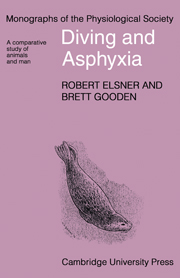2 - Metabolic conservation by cardiovascular adjustments
Published online by Cambridge University Press: 18 May 2010
Summary
Le coeur qui battait avant l'immersion environ 100 fois par minute, ne donne plus que 14 battements réguliers et profonds
(Paul Bert, 1870).Historical introduction
Robert Boyle (1670) was probably the first to experiment with diving animals when he weighted the feet of a duck and placed it in a container of water in an attempt to determine the tolerance of the duck to submersion. In 1870, the French physiologist Paul Bert made the important discovery that ducks experimentally submerged in water experienced a dramatic slowing of their heart rates. This observation initiated a long and still continuing series of investigations. Physiologists continue to reveal the intricate nature of the special diving abilities of aquatic species of birds, mammals and reptiles. In the process some interesting and unexpected discoveries in terrestrial animals, including man, have come to light.
Bert compared the duck and hen with regard to resistance to diving asphyxia. Bert suggested that the superior performance of ducks compared to hens was related to its larger blood volume to body weight ratio (1:17 in the duck, 1:30 in the hen), noting that bleeding the duck reduced its diving capability. Bert concluded that the advantage possessed by the duck could be accounted for by the greater oxygen storage capacity of its larger blood volume. This has turned out to be only part of the story.
Richet (1894, 1899) showed that ducks which had been bled to a blood volume to body weight ratio equivalent to or even less than that of hens still survived immersion for longer than might be expected on the basis of differences in relative blood volume alone.
- Type
- Chapter
- Information
- Diving and AsphyxiaA Comparative Study of Animals and Man, pp. 14 - 29Publisher: Cambridge University PressPrint publication year: 1983
- 2
- Cited by



